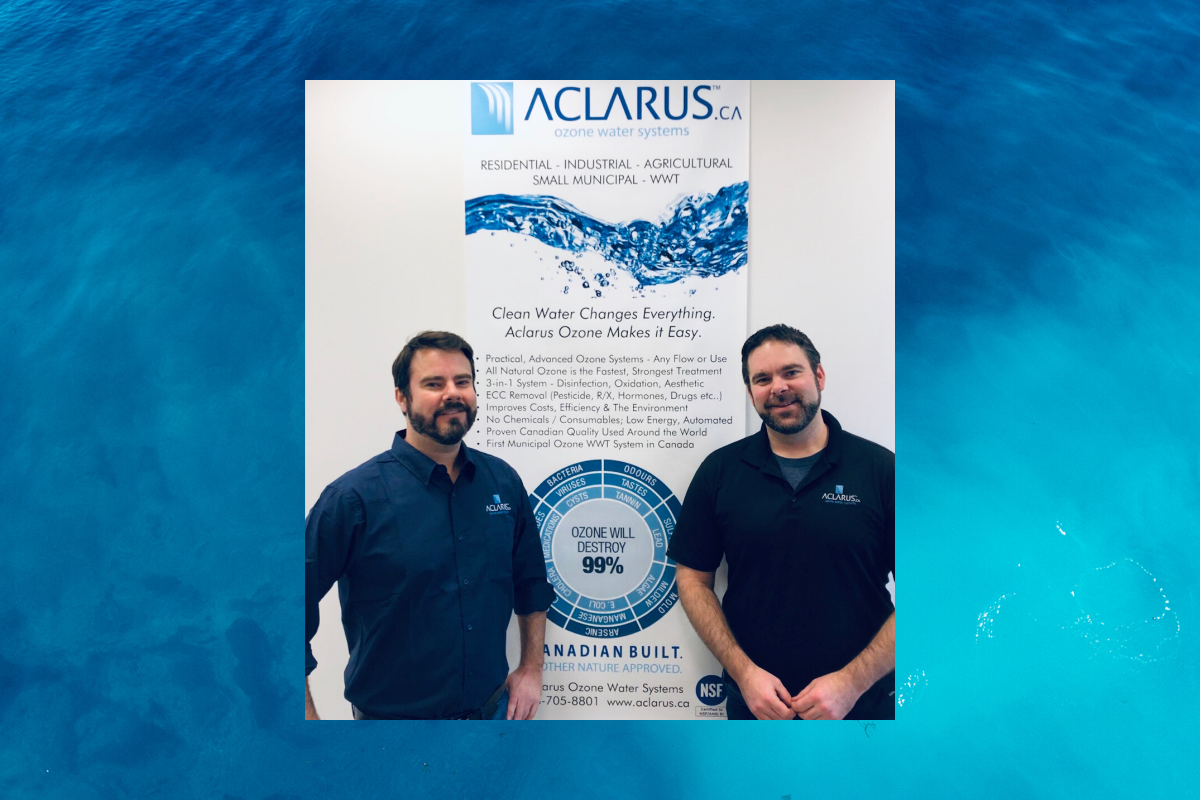For more than a century, ozone has been recognized as a powerful water and wastewater disinfectant. It destroys bacteria, viruses and hard-to-treat cysts. It oxidizes iron, manganese and sulphur and tackles aesthetic issues like colours, tastes and smells. It can even treat emerging contaminants such as drugs and pesticides.
According to Aclarus Ozone co-founder Adam Doran, that makes it a great alternative to chlorine when designed properly. “It’s one of the strongest treatment tools in the toolbox,” he explains. “It’s faster, stronger and safer than chlorine, and it’s made on site. But more importantly, it’s all natural and doesn’t leave a chemical residual in the water – only oxygenated water.”
Generating this high-performance gas is done by passing an electric current through air which converts oxygen (O2) into ozone (O3), but mixing it with the water is critical as is integrated controls. Which is why Aclarus are knowledge leaders in the design and build of ozone systems — with a little help from the Ontario Water Consortium (OWC).
Getting the right mix
According to Doran, inefficient mixing technology can let valuable ozone escape into the air. That’s a waste of money, because producing ozone can be an energy-intensive process.
In 2017, Aclarus received funding from the Advancing Water Technologies (AWT) program to help them optimize their ozone delivery process. It allowed the company to collaborate with researchers at Fleming College’s Centre for Advancement of Water and Wastewater Technologies (CAWT).
By taking advantage of the Centre’s research and development facilities, analytical instrumentation and expertise, they were able to create a standalone system that improved ozone saturation and contact time. The new system ensures over 90 per cent of the ozone generated stays in the water, disinfecting and oxidizing contaminants. And as a result, it has reduced operating costs to just five cents per thousand litres.
Best of all, Aclarus now has hard numbers to show prospective customers proving the efficiency of their system. “This is a big differentiator for us,” Doran says. And the project yielded an unexpected bonus as well, introducing Aclarus to Dr. Brent Wootton, who had managerial oversight of the CAWT. In February, the company enticed him to join their growing team as Vice President of Technology and Customer Success.
Expanding into new markets
Today, business is booming for the Peterborough enterprise. Much of that growth has been driven by expansion from their original residential market into a host of other sectors: rainwater treatment, municipal systems, provincial parks, bottled water plants, food and beverage companies, industrial process water and more.
One particularly exciting application is in remote First Nations communities. Through a partnership with Kawartha-based MS Filter Systems, Aclarus incorporated their modular ozone treatment technology with slow sand filtration.
Because there are no chemicals to ship in and the systems don’t need specialized expertise to run, they’re ideally suited for remote settings. “We are honoured to have worked with MS Filter on six First Nations communities in the last two years to help them address their drinking water challenges,” says Doran. “And with four more anticipated for 2020, we’re really proud to be contributing to removing boil water advisories.”
He’s also proud of how their technology has transformed wastewater treatment in Cobourg, Ontario. A few years ago, the municipal plant switched from chlorinating their outgoing wastewater to treating it with an ozonation system from Aclarus. That move has eliminated the discharge of thousands of kilograms of chemicals into Lake Ontario each year — and also cut operating costs by about eight per cent.
Eyeing exports
Commercializing new water technology isn’t easy, according to Doran. “It’s a lot of missionary work,” he says. “We had to do a lot of pilots, a lot of demos, a lot of proposals, a lot of phone calls and explanations.”
That’s why OWC support has been so important. Not only did AWT funding help Aclarus improve their technology and provide crucial data, the Consortium also helped Aclarus forge connections with important industry players at events like the 2019 Advancing Water Technologies Conference.
Since the AWT project wrapped up in 2019, Aclarus’s revenues have risen 80 per cent.
According to the company’s latest figures, their technology is creating cleaner water at more than 900 sites around the world. The bulk of those are currently in Ontario and across Canada, but they’ve also sold systems to customers in the United States, Australia, Mexico, Ecuador, Costa Rica, Cyprus and even Papua New Guinea.
In February, the company was acquired by 1440 Capital, a private equity group, which will accelerate their growth even further. “It’s been a whirlwind,” says Doran. “We’re just trying to manage the sort of demand we’re getting.”
Sales last year hit $1.8 million, and Aclarus aims to reach $5 million within the next two to three years by growing both their domestic and export markets. Meanwhile, they’ve hired three new employees in the last year, including Dr. Wootton — numbers that will just keep growing.
“The sky’s the limit for us now,” says Doran.


